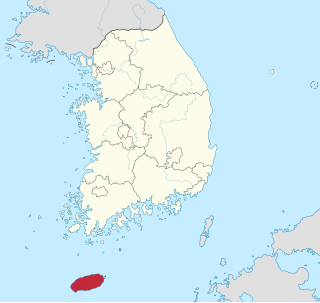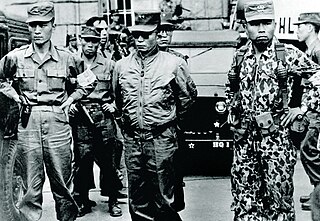Contents
| |||||
| Centuries: | |||||
|---|---|---|---|---|---|
| Decades: | |||||
| See also: | Other events in 1960 Years in South Korea Timeline of Korean history 1960 in North Korea | ||||
Events from the year 1960 in South Korea.
| |||||
| Centuries: | |||||
|---|---|---|---|---|---|
| Decades: | |||||
| See also: | Other events in 1960 Years in South Korea Timeline of Korean history 1960 in North Korea | ||||
Events from the year 1960 in South Korea.

The history of South Korea begins with the Japanese surrender on 2 September 1945. At that time, South Korea and North Korea were divided, despite being the same people and on the same peninsula. In 1950, the Korean War broke out. North Korea overran South Korea until US-led UN forces intervened. At the end of the war in 1953, the border between South and North remained largely similar. Tensions between the two sides continued. South Korea alternated between dictatorship and liberal democracy. It underwent substantial economic development.

Syngman Rhee was a South Korean politician who served as the first president of South Korea from 1948 to 1960. Rhee is also known by his art name Unam. Rhee was also the first and last president of the Provisional Government of the Republic of Korea from 1919 to his impeachment in 1925 and from 1947 to 1948. As president of South Korea, Rhee's government was characterised by authoritarianism, limited economic development, and in the late 1950s growing political instability and public opposition.

Yun Po-sun was a South Korean politician and activist who served as the second president of South Korea from 1960 to 1962. He was the only president of the short-lived Second Republic of Korea, and served as little more than a figurehead due to its nature as a parliamentary system.

The Jeju uprising, known in South Korea as the Jeju April 3 incident, was an uprising on Jeju Island from April 1948 to May 1949. A year prior to its start, residents of Jeju had begun protesting elections scheduled by the United Nations Temporary Commission on Korea (UNTCOK) to be held in the United States-occupied half of Korea, which they believed would entrench the division of the country. A general strike was later organized by the Workers' Party of South Korea (WPSK) from February to March 1948. The WPSK launched an insurgency in April 1948, attacking police and Northwest Youth League members stationed on Jeju who had been mobilized to suppress the protests by force. The First Republic of Korea under President Syngman Rhee escalated the suppression of the uprising from August 1948, declaring martial law in November and beginning an "eradication campaign" against rebel forces in the rural areas of Jeju in March 1949, defeating them within two months. This resulting campaign has lead to the event being called the Jeju massacre. Many rebel veterans and suspected sympathizers were later killed upon the outbreak of the Korean War in June 1950, and the existence of the Jeju uprising was officially censored and repressed in South Korea for several decades.

The April Revolution, also called the April 19 Revolution or April 19 Movement, were mass protests in South Korea against President Syngman Rhee and the First Republic from April 11 to 26, 1960, which led to Rhee's resignation.

The Supreme Council for National Reconstruction (Korean: 국가재건최고회의) was the ruling military junta of South Korea from May 1961 to December 1963.

The Second Republic of Korea was the government of South Korea from April 1960 to May 1961.

Chang Myon was a South Korean statesman, educator, diplomat, journalist and social activist as well as a Roman Catholic youth activist. He was the only prime minister of the parliamentary Second Republic. In addition, during the First Republic he was the fourth and last vice president of South Korea. His art name was Unseok (운석). His English name was John Chang Myon.

Shin Song-mo or Shin Sung-mo was a Korean independence activist and politician. He was an acting prime minister in 1950 following the first prime minister of South Korea, Lee Beom-seok. He served as a Defence Minister during the Korean War.

Yi Yun-young was an independence activist, educator, and Methodist minister during the Japanese occupation of Korea. His family clan originated in Danyang, and he was from Yongbyon in Pyonganbuk-do. His art name was Baeksa. During the March 1st Independence Movement, he was arrested for holding a lecture declaring independence and protesting against the Japanese occupation. In 1940, his pastoral qualifications were suspended because he opposed the unification of the churches in Korea and Japan and refused to adapt Sōshi-kaimei. After the Liberation, he participated with Cho Man-sik in the Committee for the Preparation of Korean Independence, founded the Korean Democratic Party, and was active as the party's vice leader. After his escape to the South, he was recommended as acting prime minister. After the establishment of Korea's government, he was named to be the first prime minister, but he was defeated because of the rejection of his confirmation by the Korea Democratic Party. After that, he was named to be the prime minister three more times, but each time he was rejected. Being one of Syngman Rhee's closest allies, he served as Minister without Portfolio and Minister of Social Affairs during the First Republic. He ran for vice president representing the anti-Lee Ki-poong faction but was defeated. After the May 16th Coup, he was Chairman of the Committee for Struggle against the prolongation of Military Government and executive member of the People's Party. He was an aide of Cho Man-sik, then after he defected to the South, he worked as an aide to Syngman Rhee.
Yun Chi-Young was a Korean independence activist, journalist, and politician, diplomat of South Korea. He was the first Interior Minister (1948), 2nd Republic of Korea Ambassador to France from 1950 to 1951, 1st, 2nd and 3rd National Assembly of South Korea and 13th Mayor of Seoul from 1963 to 1966. His art name is Dongsan (Korean: 동산).

The May 16 military coup d'état was a military coup d'état in South Korea in 1961, organized and carried out by Park Chung Hee and his allies who formed the Military Revolutionary Committee, nominally led by Army Chief of Staff Chang Do-yong after the latter's acquiescence on the day of the coup. The coup rendered powerless the democratically elected government of Prime Minister Chang Myon and President Yun Posun, and ended the Second Republic, installing a reformist military Supreme Council for National Reconstruction effectively led by Park, who took over as chairman after Chang's arrest in July.
Indirect presidential elections were held in South Korea on 12 August 1960, which saw the election of Yun Posun as President of the Republic of Korea, a ceremonial political position in the Second Republic. Held after the April Revolution which had forced the resignation of Syngman Rhee, it was the only presidential election to be held during the short era of the Second Republic, as the Republic folded after Park Chung-hee's May Coup the next year. The election was indirect, with a joint session of the House of Commons and Senate, which had been elected in July, acting as the electors. The winning candidate required the assent of two thirds of the members of both houses.
Events from the year 1953 in South Korea.
Events from the year 1952 in South Korea.
Events from the year 1972 in South Korea.
Events from the year 1971 in South Korea.
Events from the year 1983 in South Korea.
The June 3 resistance movement, also known as 6.3 resistance or the movement against the Korea-Japan negotiations was initiated in June 1964 by students and citizens against the Park Chung Hee administration effort to negotiate the normalization of South Korea and Japan diplomatic relations.
The former President of South Korea, Moon Jae-in, used a highly modified Hyundai Nexo SUV, a Genesis EQ900, and a Mercedes-Maybach W222 S600 Guard as his official state cars.